alb5410209
Paris Catacombs,1861

|
Ajouter à une autre Lightbox |
|
Ajouter à une autre Lightbox |



Avez-vous déjà un compte? S'identifier
Vous n'avez pas de compte ? S'inscrire
Acheter cette image

Titre:
Paris Catacombs,1861
Légende:
Traduction automatique: À la fin du XVIIIe siècle, les cimetières surpeuplés de Paris étaient devenus un problème médical et les autorités de la ville commencèrent à utiliser les catacombes sous les rues comme un immense lieu de sépulture. Elles furent ouvertes au public et les artistes suivirent bientôt, suscitant un nouvel intérêt pour le macabre. Bien que le préfet de Paris ait officiellement fermé les catacombes au public en 1830, les amateurs de l'étrange avaient périodiquement accès aux voûtes souterraines. Connu principalement pour ses portraits, Nadar a pris cette photographie du décor macabre avec une lumière artificielle de sa propre conception, une ancienne lampe à arc connue sous le nom de régulateur Serrin. Nadar, 1861 (recadrée et nettoyée)
By the end of the 18th century, overcrowded cemeteries in Paris had become a medical problem and city officials began to use the catacombs beneath the streets as a massive burial ground. They were opened to the public and artists soon followed, generating a new interest in the macabre. Although the prefect of Paris officially closed the catacombs to the public in 1830, lovers of the bizarre periodically gained access to the subterranean vaults. Known primarily for his portraiture, Nadar made this photograph of the ghoulish décor with an artificial light of his own design, an early arc lamp known as a Serrin Regulator. Nadar, 1861 (cropped and cleaned).
Crédit:
Album / Science Source
Autorisations:
Modèle: Non - Propriété: Non
Questions sur les droits?
Questions sur les droits?
Taille de l'image:
3333 x 4060 px | 38.7 MB
Taille d'impression:
28.2 x 34.4 cm | 11.1 x 13.5 in (300 dpi)
 Pinterest
Pinterest Twitter
Twitter Facebook
Facebook Copier le lien
Copier le lien Email
Email
